The Leshan Buddha, fondly called, “Da Fo” or Big Buddha (大佛), is an amazing feat of ancient architecture and manpower. Carved into the side of Mt. Lingyun, the colossal statue at 71 meters tall (233 feet) stands over 1,300 years old and is considered to be the largest stone Buddha in the world – by far the tallest pre-modern statue. This sacred, ancient wonder of the world was declared a UNESCO World Heritage Site in 1996 and attracts millions of people every year, including Buddhist pilgrims AND ME!
The statue’s history is fascinating! The story goes that the turbulent waters of three converging rivers (the Min River, Qingyi River, and Dadu River) were plaguing the local populace. Passing boats faced a significant risk, and numerous deaths occurred each year due to the unsafe conditions. Many fervently believed the cause of their suffering was an angry water spirit.

A memorial for Hai Tong
In the Tang Dynasty (618ACE to 907ACE), a monk named Hai Tong took it upon himself to save the people by carving a massive Maitreya statue at the junction of the three rivers, with the belief that it would appease the water spirit. Twenty years passed before Hai Tong was able to acquire enough funds, with many of these years spent begging for alms. Legend has it that a few local government officials demanded large sums of money from Hai Tong. He told them they could have his eyeball, but not the money he raised for this important statue. He then proceeded to dig out his eyeball and offered it to them as proof of his sincerity and devotion to the cause!
Needless to say, the officials backed off and building commenced in 713 ACE. Sadly, Hai Tong passed away while the statue was only half finished. Two of his disciples continued his work, and the project was finished after a total of 90 years. While Hai Tong wasn’t able to see the fruits of his labor in person, his wish for protecting his people was met! An unforeseen causal effect of construction occurred where so much stone was removed from the cliff face and deposited into the waters below, that the currents of the river were, in fact, altered! His legacy lives on as the area was safe from then on for passing ships.
Setting off
It was a gorgeous, bright sunny morning as I journeyed solo to the very large Chengdu East railway station and caught my train to the town of Leshan (乐山). It’s a convenient ride about 137 km (82 mi) south of Chengdu. My first impressions of the area upon arrival were that it was clean, spacious and developed (most likely from tourism boom that came with the completion of its convenient railway station in 2014). There were lots of wide streets, beautiful gardens, lush foliage, and tall buildings. It was very pretty, despite the heat.
I had researched online that I could simply take a cheap public bus for over an hour to see the giant Buddha. Since I had the entire day to hang out here, I decided to take my time and save money by riding the bus. I crossed the large empty space in front of the railway exit, ignored the usual crowd of loud, pushy unofficial taxi drivers, and walked towards the bus stop my phone’s gps was telling me to take. It was a bit confusing, the road signs not being particularly helpful, but I eventually found that I could take bus 601, opposite the railway station, for 5 Kuai one way. Chinese tourists in front of me had asked the bus driver if that was the right bus to the Leshan Buddha, so I felt very confident that I had boarded the right bus.

En route, the bus passed through Leshan. Views of picturesque roads lined with palm trees and a winding river met our eyes. I also noted a dock along the way that I’d come back to later in the afternoon to take a short cruise on to see the giant Buddha from the water.
The bus dropped me off near a jungle-y walkway with overhanging banyan trees on one side and shops on another. I was a bit confused at first about where to go, but thankfully there were signs in both English and Chinese pointing the way. Perpendicular to the entrance was an information booth, but one can’t buy tickets there. The ticket booths to see the Buddha are a little farther down, toward the river. One small hut had an attendant (cash only), while another staff member oversees the atm-like ticket booth screens. Since I didn’t bring cash, I used the ticket screens to pay the 70 Kuai (about $12) entrance fee with my Alipay App on my phone. Be aware the screens didn’t have an English option when I was there, and the attendant nearby didn’t speak English.

Entrance 
Map
A Pagoda and a Temple
“Magnificent are the Giant Buddha, Surging are the waves from three rivers. Stepping into the Leshan Giant Buddha Scenic Area, you can walk between the mountains and rivers, and immerse in the views of poetry and paintings, and find the resting place of Buddhist mood in the journey of minds.”
-Quote from the Entrance Sign
I followed the signs up through a building with steles, called the Moruo Memorial Hall. While taking a break to look around at the gorgeous scenery, I spied a pagoda above the trees. I took a short detour up another long staircase to admire the Lingbao Pagoda before moving on past a flat rest area near some Daoist carvings to the Lingyun Temple.







Lingyun Temple, situated directly before the giant Buddha, is an active Buddhist temple consisting of four main halls forming a multi-tiered courtyard. I dropped in briefly to pay my respects before heading out towards my main goal.
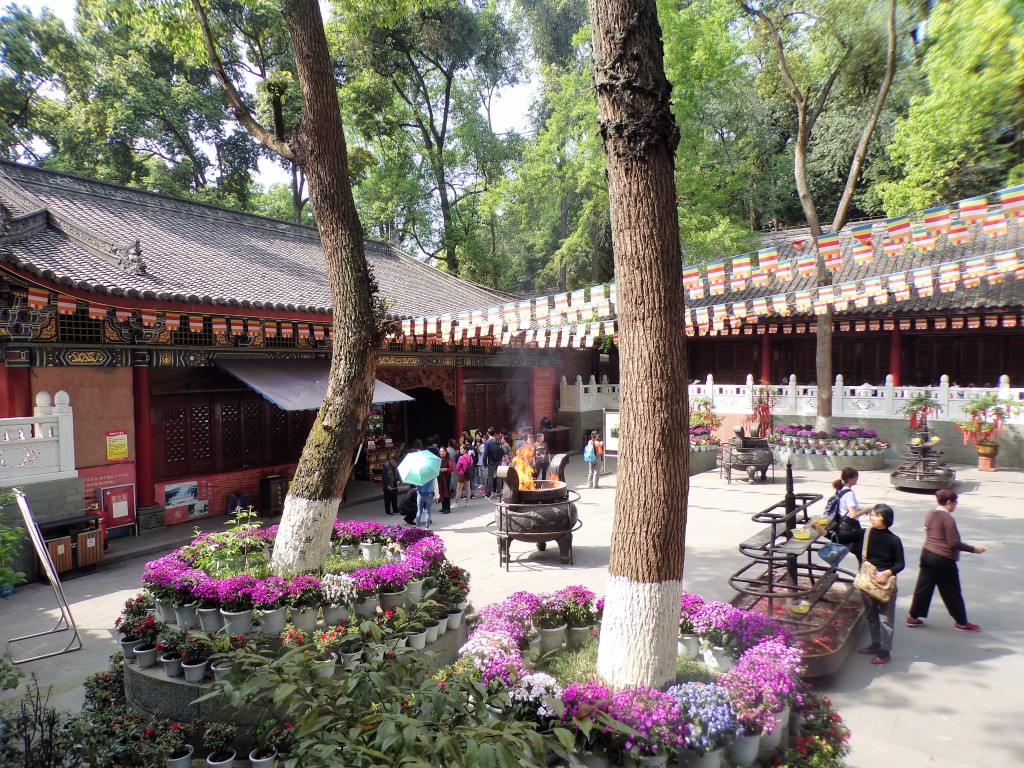

Briskly walking through and exiting the temple, I was met at the end with a large crowd and security guards. I was hoping since I came during Tomb Sweeping Festival, that most folks would be gone to actually sweep their ancestor’s tombs, but the area was busy. Elbowing my way through to the viewing platform, I found myself staring at the statue’s giant profile.

The Giant Leshan Buddha is massive! The entire statue is made of stone, except for the ears which were crafted out of wood and covered with clay. There are 1,021 twisted knots on his head. I read somewhere that the span of his neck to his shoulder is longer than a normal basketball court. Some dimensions: the Buddha is 71 meters tall (233 feet) and its head is 15 meters (50 feet) high. Each eyebrow measures 5.5 meters (18 feet) while its nose is 6 meters (20 feet) long. Each ear, measuring seven meters (23 feet), is supposedly capable of holding two people inside. Wow!
The statue was everything I’d dreamed about and more! It’s awe-inspiring and humbling to imagine all the work that was put in to make him without modern tools, and what an amazing condition he’s still in! I can understand why people take the time to make pilgrimages here. Just being in the statue’s presence, I felt an encompassing sense of calm and optimism.


The statue is ten stories high. If it stood upright, it would be almost eye to eye with the Statue of Liberty!
I debated waiting in line or continuing up the path to view other sites on the nearby island: apart from this giant Buddha, there are thousands of other carved Buddhas in and around the mountain (the entire mountain is considered a museum of Buddhist carvings and statues). The Oriental Buddha Park (Dongfang Fodu) is said to hold more than 3000 Buddhist statues, including a 170-meter-long reclining Buddha, the largest in the world. Additionally, there are Han dynasty tombs, numerous temples and shrines, and a historic fishing village. However, I decided that since I came to see Leshan Buddha specifically, and this was the only way to get a closer look at the statue, I might as well wait to go down the “Nine Bends Plank Road” (Jiuqu Zhandao, 九曲栈道).

Boy, did I wait. I think I stood in line for about two to three hours. It was sweltering and not much fun alone. I eavesdropped on more than a few conversations (most were centered on the foreigners up ahead. One girl was trying to convince her friend that, yes, foreign men found bigger girls like her attractive).
A big screen nearby replayed the same advertisements over and over for Lingyun Temple along with an info graphic about being “civilized” – warning to be respectful by not taking pictures where prohibited, not cross barriers, and to throw away your trash in the proper trash receptacle. I really appreciated that, as Chinese tourists tend to live up to their negative stereotypes (especially in China). The wait was worth it though, to climb down the 217 steps of the “Nine Bends Plank Road” (named for its nine bends or turns) and see Leshan Buddha from different angles.



All along the red sandstone cliff walls were ancient carvings of buddhas and scriptures, some too worn down by erosion to really tell what they were. There was also a sad amount of graffiti. Yet, amazingly, Leshan Buddha seems to be in really condition for its age.

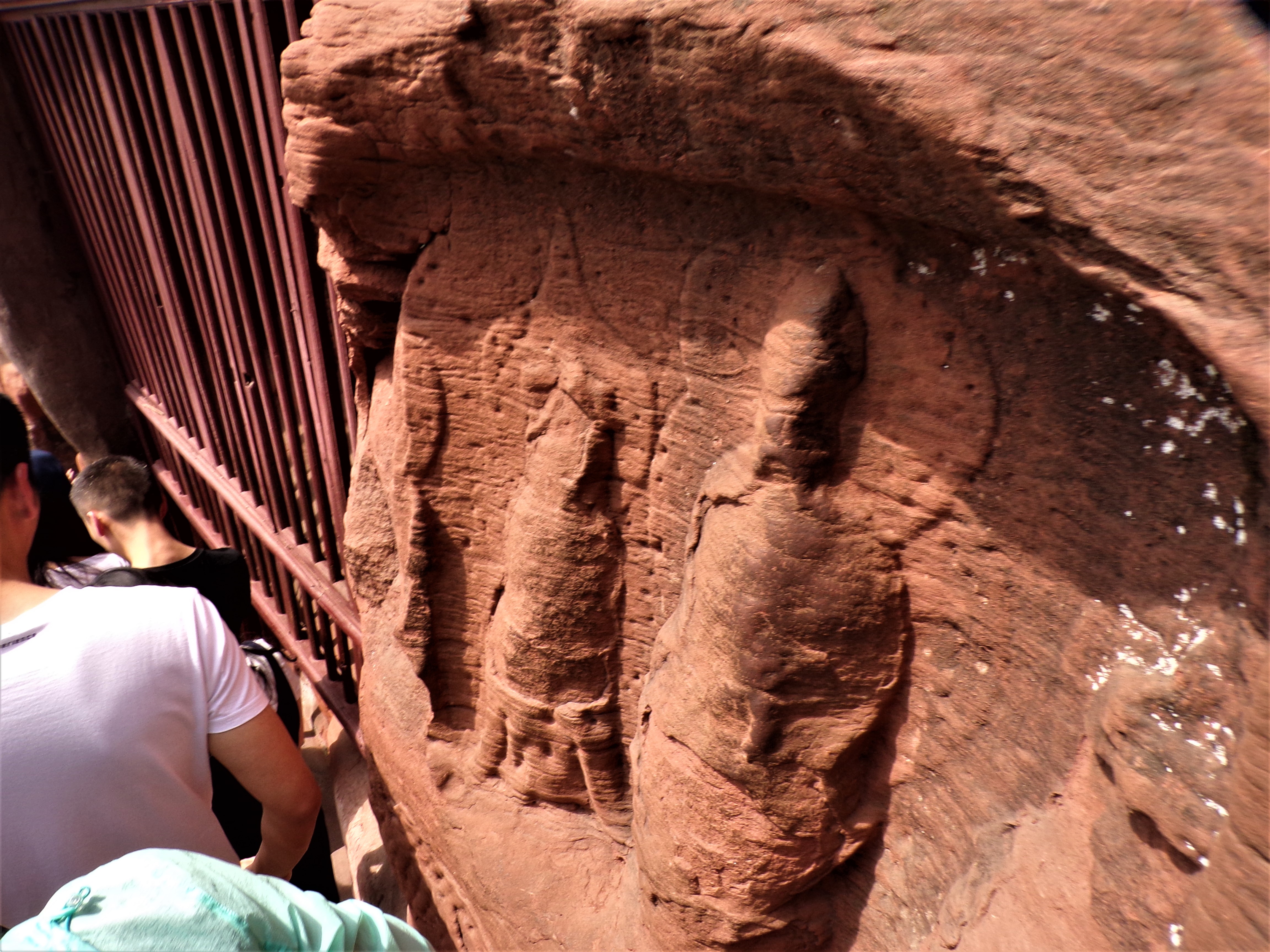


Preventing Erosion
A big reason the big Buddha looks so good is that its architects ingeniously built in a hidden water drainage system within the Buddha’s hair, collar, chest, and back of his ears that have prevented the statue from serious erosion and weathering through the years. The drainage system is made up of hidden gutters and channels that carry away rainwater and keep its innards dry.
It wasn’t always so exposed. Back in the time of its creation, this Buddha actually sat within a huge 13-story wooden pagoda for protection, but the pagoda fell towards the end of the Ming Dynasty (1600s-ish), exposing the stature to the elements. I’ve read it was nearly destroyed by wind a nd rain before 1963, when the Chinese government stepped in to prioritize its protection. Since 2001, supposedly over 40 million U.S. dollars have been spent on its repairs. A large modern problem it faces is the harmful effects of pollution.
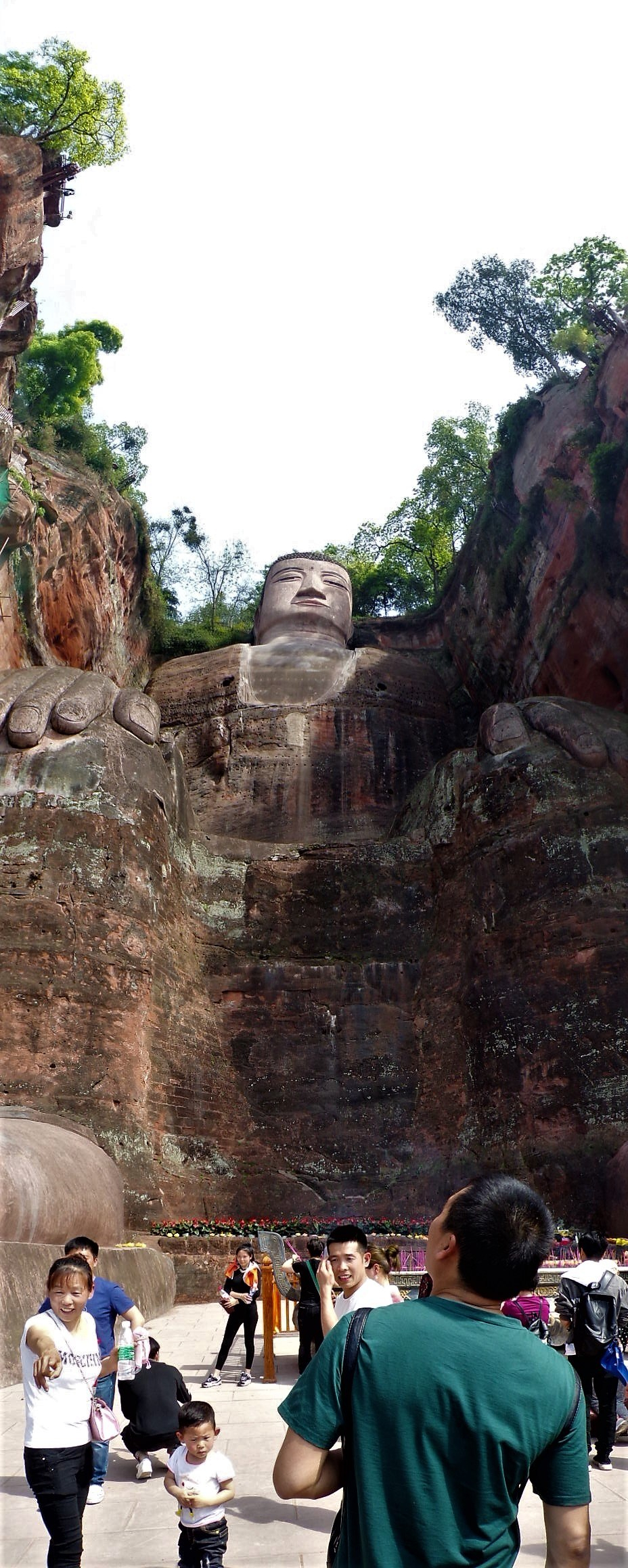

It’s said that 100 monks could sit on one of the statue’s feet!

After climbing up the exit steps on the other side of the Buddha, my legs felt pretty wrecked. The steps down were fun. The ones going up, not so much. There are little rest areas carved into the mountain along the path, but most were covered in trash and smelled of urine, discouraging anyone from actually resting there. Sweating up a storm, I bought an ice-cream and bottled water (thankfully refrigerated) from a vendor at the top of the steps and had a rest with the other tired visitors scattered about along stone seats.
Rather than continue on (the paths to more sites looked like they involved more upward hiking), I turned around at this point to make my way back to the docks I saw hours ago on my bus ride in. It was easy to find the path back to the exit (I actually ended up walking right by the spot the bus initially dropped me off). I followed a walking path by the river until I reached souvenir stalls and a bunch of yachts.

On a Boat!
Ninety Kuai (about $15) bought me a spot on an hour-long cruise up the river. Those of us who wanted to stand on the deck were told to wear life jackets (free to take them off for photos, though). I seemed to have chosen a good time as there was only one other boat on the water. The ride was super chill, the afternoon sun was beautifully reflected on the waves and egrets flew overhead.


The view of the Buddha from the water spectacular! I was glad I chose to do both the walk and the cruise (despite the pain) as the cruise gave me a surprising look at two large carved stone warriors holding a halberd on either side of Leshan Buddha. I wouldn’t have seen them otherwise!

Thoughts
Overall, I had a great day! I accomplished my goals, navigated a new city on my own, and saw some incredible sights while doing so. I’d love to come back with friends or family. Had I an extra day on this trip, I think I would’ve tried to visit the holy Mt. Emei, located a further 20-minute train ride down the same line. Mt. Emei or Emeishan is one of the Four Sacred Mountains of Buddhism and is another UNESCO site.
For those traveling to Leshan to see the giant Buddha, I recommend trying to come here during a weekday or a non-holiday weekend, if possible, otherwise be prepared to wait a few hours to go down the Nine Plank Road like I had to. Yet, I think seeing Leshan Giant Buddha up close is worth it!








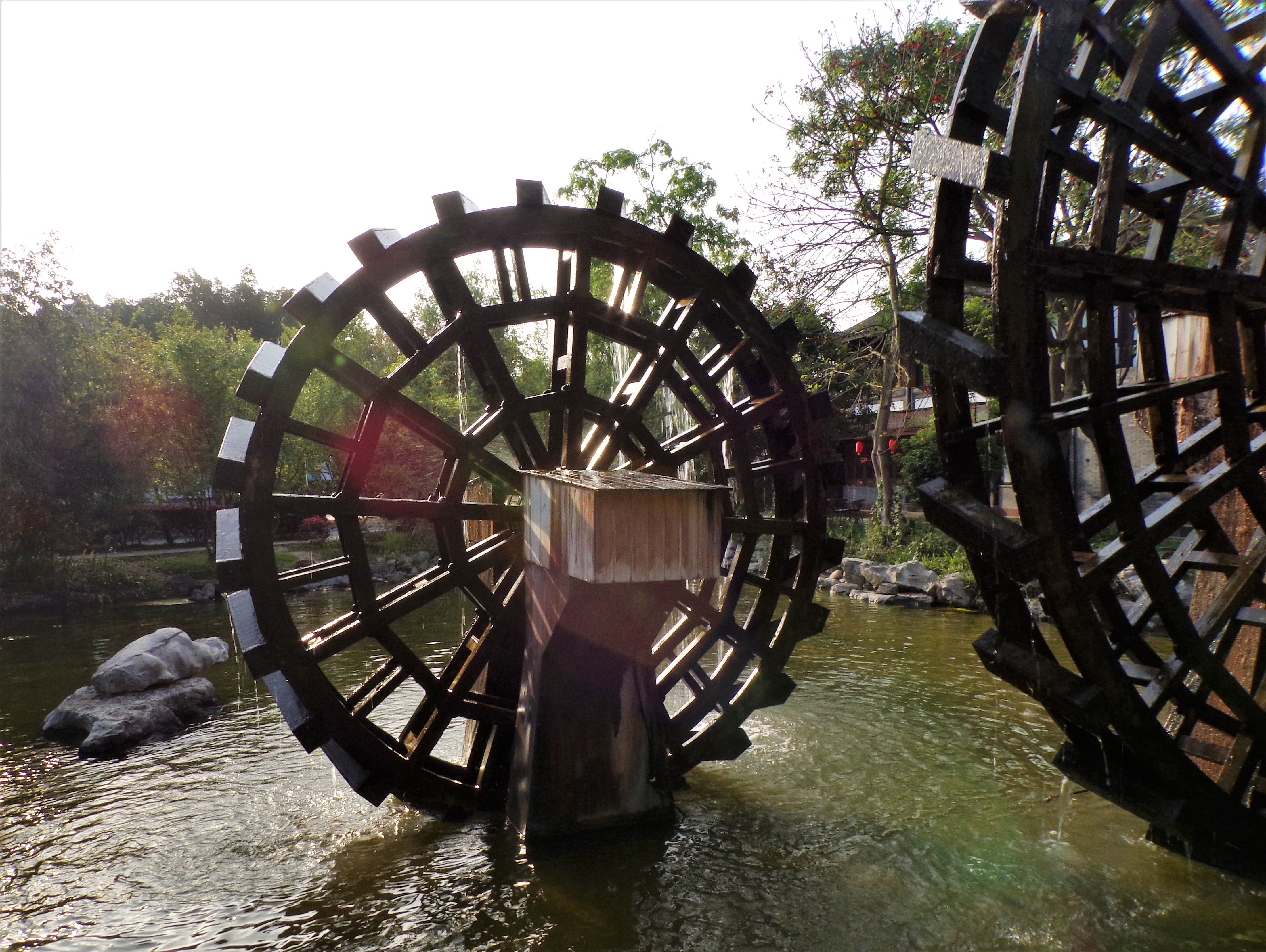





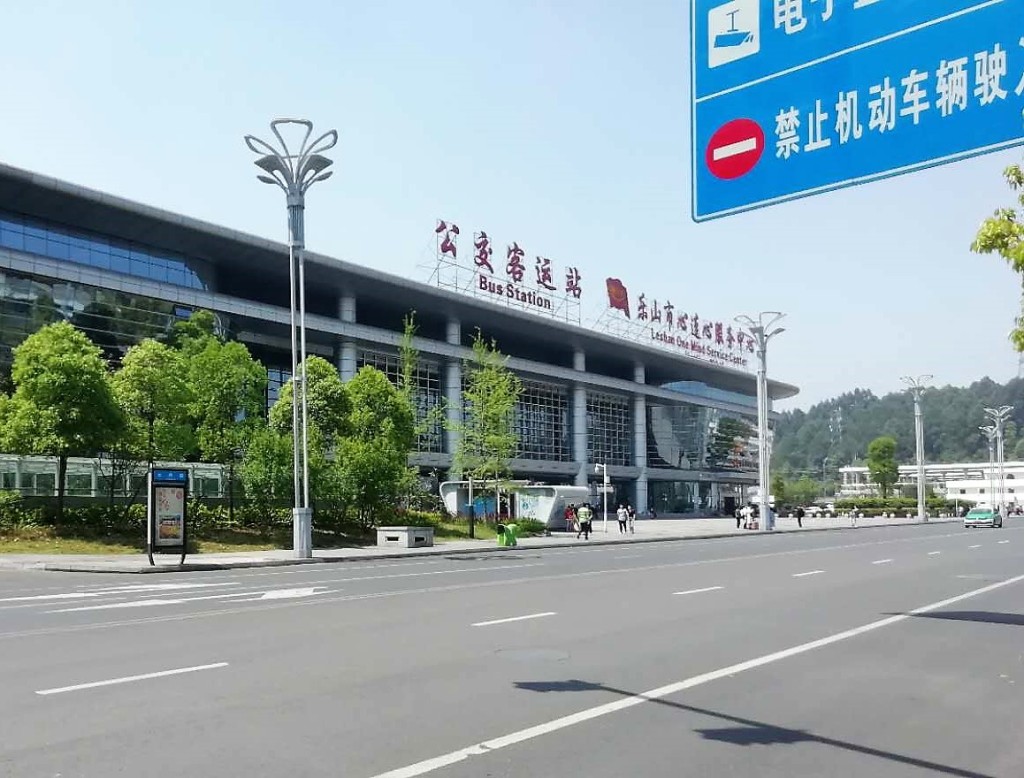



Fantastic items from you, man. I have consider your stuff prior to and you’re just extremely excellent. I actually like what you have obtained right here, certainly like what you’re stating and the best way in which you are saying it. You are making it enjoyable and you continue to care for to stay it sensible. I cant wait to learn much more from you. That is actually a wonderful site.
LikeLike
Wow this is so incredible! I can’t believe I hadn’t heard of this UNESCO site before. I have been to Beijing and Hong Kong years ago but would love to explore more of China one day 🙂
LikeLiked by 1 person
It’s an amazing feat to see in-person! I would highly recommend a stop by whenever you make it back 🙂
LikeLike
I enjoyed reading this, your descriptions took me right to this holiday and I now want to see the Buddha statue. How clever is that drainage system too.
LikeLiked by 1 person
I would be so interested in visiting this! I’ve seen photos of it before but never a description as detailed as you’ve given here. One to add to the bucket list – thank you!
LikeLiked by 1 person
Fascinating!! I’ve never heard of this before! That’s a lot of stairs too but I would be so excited to get down them. Sad about the graffiti but I think that’s probably common at a lot of tourist attractions. Definitely marking this one down – I bet it’s quite impressive to see in person!!
LikeLiked by 1 person
Wow! What an incredible statue – and I’ve never even heard of it before! Thanks for sharing your experience. I would love to visit one day!
LikeLiked by 2 people